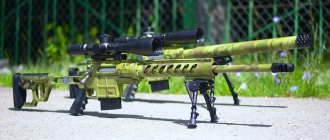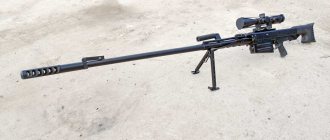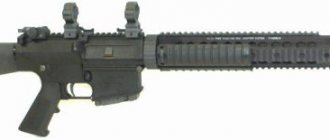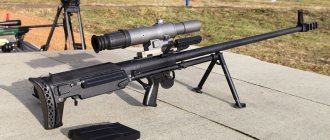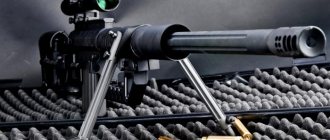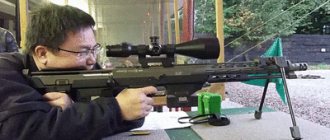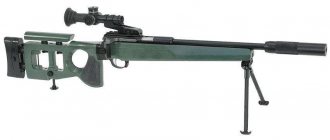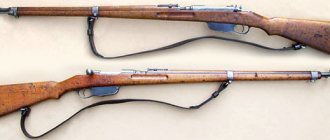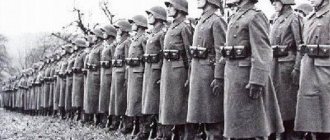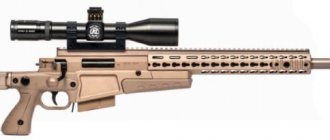04.06.2013
Sniper rifle MK12 MOD0/MOD1 (USA)
The Mk12 MOD Special Purpose Rifle, like its predecessor, the Mk12 MOD0 Special Purpose Rifle, belongs to the AR-15/M16 family of weapons. It is a 5.56×45 caliber automatic weapon using the principle of removing powder gases, used by the US Marine Corps in Afghanistan to engage targets at ranges up to 800 m. The rifles were originally developed to meet the needs of the Navy and Special Forces US Army in a new self-loading sniper and precision rifle. The history of the development of this weapon can be traced back to the Special Operations Peculiar Modification Kit program, abbreviated SOPMOD, developed in the 1990s.
SOPMOD kits were sets of components for retrofitting the M4A1 carbine, with the installation of which weapons, previously used only by special units, could be adapted for special operating conditions. When using retrofitting elements, aiming and target identification capabilities are improved, reaction time is reduced and shooting accuracy is improved, both in the close range and when using weapons at ranges of up to 600 m, day and night. The first SOPMOD kits were issued to the troops in 1995 and included the following components: ACOG-x4 sight, AN/PEQ-2A laser/light module, mounted 40-mm M203 grenade launcher, silencer, AN/PVS-17A night sight, handguard with four Picatinny rails according to military standard MIL-STD-1913.
As part of the development of the SOPMOD kit program, the Crane division of the US Navy Land Warfare Center began thinking about converting the M4A1 carbine into a sniper rifle by installing retrofitting units. Subsequently, these plans grew into an independent project, which led to the creation of the Mk12 MOD0 and Mk12 MOD1 special purpose rifles. In early 2003, the first Mk12 MOD1 SPR rifles entered service with the US Special Operations Command (SOCOM). in November of the same year, Mk12 MOD1 SPR rifles were issued to US Marine Corps units that participated in operations in Iraq and Afghanistan. Weapons for the United States Marine Corps are produced by the Precision Weapons Section of the training battalion located at the Marine Corps Base at Quantico, Virginia. In order to achieve the highest possible accuracy and keep manufacturing tolerances as low as possible, components only from specially certified manufacturers are used for the production of weapons.
The Mk12 MOD1 special purpose rifle, caliber 5.56×45, when unloaded, with a silencer, and a Leupold Mk.4 2.5-8×36 optical sight, weighs 5.5 kg, is 184 mm high and 82 mm wide. The length of the weapon without a silencer is 946 mm, with a silencer -1067 mm. The theoretical rate of fire without a silencer is from 625 to 650 rounds/min; with a silencer it rises to 775-800 rounds/min. Although the Mk12 MOD1 can also fire in short bursts and continuously fire, it should be mentioned that it was not designed for this.
The first Mk12 MOD1 trigger boxes were produced using those from the M16A1, while later production Mk12 MOD1s were based on the M4A1 design. They are equipped with match triggers, two-stage, with warning and a trigger force of 2 kg. manufactured by s Armament and has four military standard MIL-STD-1913 Picatinny rails, each 286 mm long. Along with other components, a front sling swivel for carrying a belt is installed on the bar.
The Mk12 MOD1 rifle has a long free-oscillating barrel with six right-hand rifling; rifling pitch - 7 inches (178 mm). The barrel length is 472.5 mm (18.6 in). The special shape of the barrel improves heat dissipation conditions and accuracy of fire while simultaneously reducing weight. Barrels for the Mk12 MOD1 are made by three different companies: Douglas Barrels Incorporated, Lewis Machine & Tool Company and Barrel Barn. Gas removal is carried out using a gas block mounted on the barrel, which is manufactured by the Crane division of the US Naval Land Warfare Center.
The Mk12 MOD1 SPR rifle uses the Leupold Mk4 2.5-8×36 MR/T M2 optical sight with Tactical Milling reticle. The aiming mark can be illuminated. The stable, waterproof sight weighs 454 g and has a length of 287 mm. The sight is optimized for use in twilight, and allows the shooter to clearly distinguish contours and targets even in low light. To eliminate glare, the sight has flip-up lens and eyepiece covers. The vertical and horizontal adjustment range is 90 arc minutes.
Adjustment is carried out with “clicks”; the price of a “click” is 1/4 arc minute. The sight is mounted to the Picatinny rail of the receiver using mounting rings from Atlantic Research Marketing Systems Incorporated. In case the optical sight is damaged, the Mk12 MOD1 SPR rifle also has a mechanical sight, which consists of a folding diopter rear sight and a folding front sight, also manufactured by s Armament mounting strip, on the lower Picatinny rail of the forend.
The Mk12 MOD1 SPR Special Purpose Rifle comes in a waterproof, dustproof, shockproof Pelican 1700 weapon case. It is made from black, extremely impact-resistant polypropylene copolymer. The case weighs 7.7 kg, has a length of 968 mm, a width of 406 mm and a height of 155 mm; internal dimensions are 908 mm in length, 343 mm in width and 133 mm in height. Rifle cleaning supplies are available from Otis Technology Incorporated; It comes in a convenient nylon bag with a zipper.
Along with other components, the cleaning kit includes a Memory-Flex cleaning cord, a rag holder, and a variety of barrel cleaning brushes. Additionally, a nylon coated cleaning rod and cleaning rod guide are included with the rifle for intensive cleaning. The documents that are supplied to the troops along with the rifle include the “Operating Manual for the 5.56 mm Special Purpose Rifle Mk12 MOD1 TM11416A-OR-1,” which describes in detail the maintenance and handling of the rifle. It is provided in both printed and electronic form on CD-ROM. in pdf format. The form documents the accuracy of fire. The scope comes with an instruction and maintenance manual, as well as a description of the Tactical Milling reticle. The Mildot Master counting ruler is very useful, with the help of which, using the data obtained from the reticle. you can quickly and easily determine the distance to the target and the drop of the bullet relative to the throwing line. A table with ballistic data is equally useful.
The Mk12 MOD1 Special Purpose Rifle can fire all 5.56x45 caliber cartridges accepted by the US military. Especially for use with this rifle, cartridges with a special 77-grain (5 g) bullet for shooting at long distances Mk2b2 MOD0/MOD1 AA53 (77 gr Long Range Special Ball Mk262 MOD0/MODl AA53) are issued. These cartridges use a 77-grain match bullet with a hollow point and tapered tang (CRVT). The Mk262 MOD0 cartridges are produced using Sierra Matchking bullets from Black Hills Ammunition. The Mk262 MOD1 cartridge uses Sierra Matchking bullets from both Nosier Incorporated and Black Hills Ammunition. The National Defense Industrial Association (ND1A) claims the accuracy of these rounds to be less than 1 arc minute. When firing these cartridges from an M16A4 assault rifle or an M4A1 carbine, they achieve an accuracy of 2 arc minutes; standard US Army M855 infantry cartridges achieve accuracy of only 3 to 5 arc minutes. According to the Service Manual, when using Mk262 MODO/MOD1 AA53 cartridges, the Mk12 MOD1 SPR rifle can confidently hit head targets up to a distance of 600 m and height targets up to 800 m. According to official reports, snipers of special forces of the US Armed Forces, as well as marksmen of the Marine Corps with their Mk12 MOD1 SPR rifles in Afghanistan they consistently neutralize targets at ranges over 700 m.
Source
Number of impressions: 3168
See also on Spetsnaz.org:
- Taurus - pistols and shotguns at the IWA exhibition
- AGS-40 "Balkan": a destructive beast in a new guise
- Killer "Baby", Izhevsk "Baghira" and "Varyag": a powerful trio for special forces
- Hello Karl! Let's get to know each other better?
- “Smart ammunition”: Russian grenade launchers will tear apart any American armor
Sniper rifle Mk12 MOD1 (USA)
The Mk12 MOD special purpose rifle, like its predecessor, the Mk12 MOD0 special purpose rifle, belongs to the AR-15/M16 family of weapons. It is a 5.56×45 caliber automatic weapon using the principle of removing powder gases, used by the US Marine Corps in Afghanistan to engage targets at ranges up to 800 m. The rifles were originally developed to meet the needs of the Navy and Special Forces US Army in a new self-loading sniper and precision rifle. The history of the development of this weapon can be traced back to the Special Operations Peculiar Modification Kit program, abbreviated SOPMOD, developed in the 1990s. SOPMOD kits were sets of components for retrofitting the M4A1 carbine, with the installation of which weapons, previously used only by special units, could be adapted for special operating conditions. When using retrofitting elements, aiming and target identification capabilities are improved, reaction time is reduced and shooting accuracy is improved, both in the close range and when using weapons at ranges of up to 600 m, day and night. The first SOPMOD kits were issued to the troops in 1995 and included the following components: ACOG-x4 sight, AN/PEQ-2A laser/light module, mounted 40-mm M203 grenade launcher, silencer, AN/PVS-17A night sight, handguard with four Picatinny rails according to military standard MIL-STD-1913.
As part of the development of the SOPMOD kit program, the Crane division of the US Navy Land Warfare Center began thinking about converting the M4A1 carbine into a sniper rifle by installing retrofitting units. Subsequently, these plans grew into an independent project, which led to the creation of the Mk12 MOD0 and Mk12 MOD1 special purpose rifles. In early 2003, the first Mk12 MOD1 SPR rifles entered service with the US Special Operations Command (SOCOM). in November of the same year, Mk12 MOD1 SPR rifles were issued to US Marine Corps units that participated in operations in Iraq and Afghanistan. Weapons for the United States Marine Corps are produced by the Precision Weapons Section of the training battalion located at the Marine Corps Base at Quantico, Virginia. In order to achieve the highest possible accuracy and keep manufacturing tolerances as low as possible, components only from specially certified manufacturers are used for the production of weapons.
The Mk12 MOD1 special purpose rifle, caliber 5.56×45, when unloaded, with a silencer, and a Leupold Mk.4 2.5-8×36 optical sight, weighs 5.5 kg, is 184 mm high and 82 mm wide. The length of the weapon without a silencer is 946 mm, with a silencer -1067 mm. The theoretical rate of fire without a silencer is from 625 to 650 rounds/min; with a silencer it rises to 775-800 rounds/min. Although the Mk12 MOD1 can also fire in short bursts and continuously fire, it should be mentioned that it was not designed for this.
Trigger Box The first Mk12 MOD1 trigger boxes were produced using those from the M16A1, while later production Mk12 MOD1s were based on the M4A1 design. They are equipped with match triggers, two-stage, with warning and a trigger force of 2 kg. manufactured by s Armament and has four military standard MIL-STD-1913 Picatinny rails, each 286 mm long. Along with other components, a front sling swivel for carrying a belt is installed on the bar.
Barrel The Mk12 MOD1 rifle has a long free-oscillating barrel with six right-hand rifling; rifling pitch - 7 inches (178 mm). The barrel length is 472.5 mm (18.6 in). The special shape of the barrel improves heat dissipation conditions and accuracy of fire while simultaneously reducing weight. Barrels for the Mk12 MOD1 are made by three different companies: Douglas Barrels Incorporated, Lewis Machine & Tool Company and Barrel Barn. Gas removal is carried out using a gas block mounted on the barrel, which is manufactured by the Crane division of the US Naval Land Warfare Center.
Sighting device The Mk12 MOD1 SPR rifle uses a Leupold Mk4 2.5-8×36 MR/T M2 optical sight with a Tactical Milling reticle. The aiming mark can be illuminated. The stable, waterproof sight weighs 454 g and has a length of 287 mm. The sight is optimized for use in twilight, and allows the shooter to clearly distinguish contours and targets even in low light. To eliminate glare, the sight has flip-up lens and eyepiece covers. The vertical and horizontal adjustment range is 90 arc minutes. Adjustment is carried out with “clicks”; the price of a “click” is 1/4 arc minute. The sight is mounted to the Picatinny rail of the receiver using mounting rings from Atlantic Research Marketing Systems Incorporated. In case the optical sight is damaged, the Mk12 MOD1 SPR rifle also has a mechanical sight, which consists of a folding diopter rear sight and a folding front sight, also manufactured by s Armament mounting strip, on the lower Picatinny rail of the handguard.
Accessories The Mk12 MOD1 SPR Special Purpose Rifle is supplied in a water- and dust-proof, shock-resistant Pelican-1700 weapon case. It is made from black, extremely impact-resistant polypropylene copolymer. The case weighs 7.7 kg, has a length of 968 mm, a width of 406 mm and a height of 155 mm; internal dimensions are 908 mm in length, 343 mm in width and 133 mm in height. Rifle cleaning supplies are available from Otis Technology Incorporated; It comes in a convenient nylon bag with a zipper. Along with other components, the cleaning kit includes a Memory-Flex cleaning cord, a rag holder, and a variety of barrel cleaning brushes. Additionally, a nylon coated cleaning rod and cleaning rod guide are included with the rifle for intensive cleaning. The documents that are supplied to the troops along with the rifle include the “Operating Manual for the 5.56 mm Special Purpose Rifle Mk12 MOD1 TM11416A-OR-1,” which describes in detail the maintenance and handling of the rifle. It is provided in both printed and electronic form on CD-ROM. in pdf format. The form documents the accuracy of fire. The scope comes with an instruction and maintenance manual, as well as a description of the Tactical Milling reticle. The Mildot Master counting ruler is very useful, with the help of which, using the data obtained from the reticle. you can quickly and easily determine the distance to the target and the drop of the bullet relative to the throwing line. A table with ballistic data is equally useful.
Ammunition The Mk12 MOD1 Special Purpose Rifle can fire all 5.56x45 caliber ammunition accepted by the US military. Especially for use with this rifle, cartridges with a special 77-grain (5 g) bullet for shooting at long distances Mk2b2 MOD0/MOD1 AA53 (77 gr Long Range Special Ball Mk262 MOD0/MODl AA53) are issued. These cartridges use a 77-grain match bullet with a hollow point and tapered tang (CRVT). The Mk262 MOD0 cartridges are produced using Sierra Matchking bullets from Black Hills Ammunition. The Mk262 MOD1 cartridge uses Sierra Matchking bullets from both Nosier Incorporated and Black Hills Ammunition. The National Defense Industrial Association (ND1A) claims the accuracy of these rounds to be less than 1 arc minute. When firing these cartridges from an M16A4 assault rifle or an M4A1 carbine, they achieve an accuracy of 2 arc minutes; standard US Army M855 infantry cartridges achieve accuracy of only 3 to 5 arc minutes. According to the Service Manual, when using Mk262 MODO/MOD1 AA53 cartridges, the Mk12 MOD1 SPR rifle can confidently hit head targets up to a distance of 600 m and height targets up to 800 m. According to official reports, snipers of special forces of the US Armed Forces, as well as marksmen of the Marine Corps with their Mk12 MOD1 SPR rifles in Afghanistan they consistently neutralize targets at ranges over 700 m.
LiveInternetLiveInternet
The Mk12 MOD1 special purpose rifle belongs to the AR-15/M16 family of weapons.
It was originally developed for U. 5. SOCOM (Special Operations Command) units. A self-loading rifle using a propellant exhaust system is used by the US Marine Corps in Afghanistan to engage targets at ranges up to 800 m. In Iraq and Afghanistan, insurgents are waging guerrilla warfare against local security forces and coalition forces. Rebel tactics include surprise ambush attacks. However, they often fire only a few shots from long ranges and then retreat. Often rebels use civilians as human shields. This behavior makes it almost impossible for security forces to respond with fire, as it threatens civilians and causes collateral damage. The assault rifles used by the coalition forces, such as the Bundeswehr G36A2, the British Armed Forces SA80A2 and the M16A4, as well as the US Armed Forces M4A1 carbines, simply do not have the accuracy necessary to hit a target at long range. In response to this state of affairs, coalition forces began to acquire so-called “rifles for selected marksmen.” They were then adopted for use by troops engaged in operations in Iraq and Afghanistan at the squad or platoon level and issued to the best marksmen, who thus became "selected marksmen". "Selected Marksmen" are not snipers, they are marksmen who, thanks to the best weapons, are able to confidently hit targets that their comrades cannot hit. In 2009, the US Army adopted the improved M14 rifle, chambered in 7.62x51, as a "selected marksman" rifle. The British Army recently began issuing the L129A1 sniper rifle chambered in 7.62x51 at squad level. The Bundeswehr converted several G3 assault rifles chambered for 7.62×51 into “rifles for selected marksmen” to cover “immediate needs related to combat conditions.” The US Marine Corps adopted the Mk2 MODI special purpose rifle chambered for 5.56×45 as a weapon for marksmen as early as 2003. Designed for Special Forces The Mk12 MOD Special Operations Rifle, like its predecessor, the Mk12 MOD0 Special Operations Rifle belongs to the AR-15/M16 family of weapons. They are automatic weapons of 5.56×45 caliber, using the principle of removal of powder gases. The rifles were originally developed to meet the needs of the US Navy and Special Forces for a new self-loading sniper and precision rifle. The history of the development of this weapon can be traced back to the Special Operations Peculiar Modification Kit program, abbreviated SOPMOD, developed in the 1990s. SOPMOD kits were sets of components for retrofitting the M4A1 carbine, with the installation of which weapons, previously used only by special units, could be adapted for special operating conditions. When using retrofitting elements, aiming and target identification capabilities are improved, reaction time is reduced and shooting accuracy is improved, both in the close range and when using weapons at ranges of up to 600 m, day and night. The first SOPMOD kits were issued to the troops in 1995 and included the following components: ACOG-x4 sight, AN/PEQ-2A laser/light module, mounted 40-mm M203 grenade launcher, silencer, AN/PVS-17A night sight, handguard with four Picatinny rails according to military standard MIL-STD-1913. As part of the development of the SOPMOD kit program, the Crane division of the US Navy Land Warfare Center began thinking about converting the M4A1 carbine into a sniper rifle by installing retrofitting units. Subsequently, an independent project grew out of these plans, which led to the creation of special-purpose rifles Mk21 MOD0 and Mk12 MOD1. In early 2003, the first Mk12 MOD1 SPR rifles entered service with the US Special Operations Command (SOCOM). In November of the same year, Mk12 MOD1 SPR rifles were issued to US Marine Corps units that participated in operations in Iraq and Afghanistan. Weapons for the United States Marine Corps are produced by the Precision Weapons Section of the training battalion located at Marine Corps Base Quaitico, Virginia. In order to achieve the highest possible accuracy and keep manufacturing tolerances as low as possible, components only from specially certified manufacturers are used for the production of weapons. Technical features The special purpose rifle Mk12 MOD1 caliber 5.56x45 when unloaded, with a silencer, and a Leupold Mk4 2.5-8x36 optical sight weighs 5.5 kg, is 184 mm high and 82 mm wide. The length of the weapon without a silencer is 946 mm, with a silencer 1067 mm. The theoretical rate of fire without a silencer is from 625 to 650 rounds/min; with a silencer it rises to 775-800 rounds/min. Although the Mk12 MOD1 can also fire in short bursts and continuously fire, it should be mentioned that it was not designed for this. Trigger Box The first Mk12 MOD1 trigger boxes were produced using boxes from the M16A1, while later production Mk12 MOD1s were based on the M4A1 design. They are equipped with two-stage match triggers. With warning and trigger force 2 kg. manufactured by Knight's Armament. In addition, the trigger mechanism is equipped with a new trigger. Using the safety lever, in addition to the “Safety” position, you can also select firing modes - “Single” (designated Single) and “Continuous” (designated Auto; on some frames, instead of Auto, the designation Burst is applied). The magazine window is not modified, and the Mk12 MOD1 uses the same 20- or 30-round magazines as the M16L4 or M4D1. The frame and shoulder rest are the same as for the M16A4. At the Marine Corps unit level, select Mk12 MOD1s are equipped with a Magpul MY Stock - Mil-Spec retractable shoulder rest manufactured by Magpul Industries Corporation. The shoulder rest has a rubberized butt pad and an adjustment range of 83 mm (four stages of installation). Receiver and receiver pad
“Multiplication table” for the shooter: using the Mildot-Master counting ruler you can calculate firing ranges and trajectory reductions
As for the receiver, bolt carrier and rotary bolt, we are talking about standard components of the M16A4 rifle. However, parts with particularly tight manufacturing tolerances are still used, which are subjected to additional high-pressure testing and are finally checked for the presence of cracks using a magnetic flaw detector. On top of the receiver there is a Picatinny rail according to the military standard MIL-STD-1913. By replacing the conventional cocking handle with the PRI M84 Gas Buster Charging Handle manufactured by DPMS Firearms, LLC, firearm safety has been improved. The new cocking handle has an ergonomically improved locking lever with an increased supporting surface for the fingers. In addition, this cocking handle closes the receiver better than the previous one and prevents escaping powder gases and oil particles from getting into the shooter’s face. A rigidly coupled structure to the receiver, called the Rail Adapter System Free-Floating Barrel (Long) Model 21318, actually a forend, is manufactured by Knight's Armament and has four military-grade MIL-STD Picatinny rails. -1913, 286 mm long each. Along with other components, a front sling swivel for carrying a belt is installed on the bar.
Front: Knighfs Armament folding front sight is located at the front end of the forend-mounted Picatinny rail
Rear: The Mk12 MOD1 SPR iron sight includes a folding rear sight, also manufactured by Knighfs Armament
Reducing: when shooting without a silencer, a compensator provides a reduction in recoil and muzzle kick
Dimensions: with a Leupotd optical sight and silencer, the Mk12 MODI SPR rifle has a length of 1067 mm, a height of 184 mm and a width of 82 mm
Barrel The Mk12 MOD1 rifle has a long free-oscillating barrel with six right-hand rifling; rifling pitch - 7 inches (178 mm). The barrel length is 472.5 mm (18.6 in). The special shape of the barrel improves heat dissipation conditions and accuracy of fire while simultaneously reducing weight. Barrels for the Mk12 MOD1 are made by three different companies: Douglas Barrels Incorporated, Lewis Machine & Tool Company and Barrel Barn. Gas removal is carried out using a gas block mounted on the barrel, which is manufactured by the Crane division of the US Naval Land Warfare Center. Sighting Device The Mk12 MOD1 SPR rifle uses a Leupold Mk4 2.5-8×36 MR/T M2 optical sight with a Tactical Milling reticle. The aiming mark can be illuminated. The stable, waterproof sight weighs 454 g and has a length of 287 mm. The sight is optimized for use in twilight, and allows the shooter to clearly distinguish contours and targets even in low light. To eliminate glare, the sight has flip-up lens and eyepiece covers. The vertical and horizontal adjustment range is 90 arc minutes. Adjustment is carried out with “clicks”; the price of a “click” is 1/4 arc minute. The sight is mounted to the Picatinny rail of the receiver using mounting rings from Atlantic Research Marketing Systems Incorporated. In case the optical sight is damaged, the Mk12 MOD1 SPR rifle also has a mechanical sight, which consists of a folding diopter rear sight and folding front sight, also produced by the iVIBS 5.56 mm Precision Suppressor. This muffler is manufactured by OPS Incorporated. It simply screws onto the compensator located on the muzzle of the rifle; the cuff that slides over the barrel serves for centering. When shooting without a silencer, the compensator reduces recoil and muzzle kick. Thanks to the removal of powder gases to the sides and upwards, it also prevents the appearance of clouds of dust when firing. The hole in the muzzle of the compensator is 0.762 mm larger than the diameter of the bullet. The muffler has a length of 216 mm and a diameter of 38 mm, It is made of 300 series alloy steel, explosion welded. According to the manufacturer, the sound dampening efficiency is 40 dB. The bipod of the Mk12 MOD1 SPR rifle is a Harris Engineering HBRM-S model. Its supports can be extended from 153 to 228 mm in 25 mm increments. A hinge integrated into the base of the bipod, the rotation force of which can be adjusted, allows the shooter to prevent the rifle from stalling on uneven surfaces. The bipod is installed using a mounting plate manufactured by Knight's Armament on the lower Picatinny rail of the forend. Accessories The Mk12 MOD1 SPR Special Purpose Rifle is supplied in a water- and dust-proof, shock-resistant Pelican-1700 weapon case. It is made from black, extremely impact-resistant polypropylene copolymer. The case weighs 7.7 kg, has a length of 968 mm, a width of 406 mm and a height of 155 mm; internal dimensions are 908 mm in length, 343 mm in width and 133 mm in height. Rifle cleaning supplies are available from Otis Technology Incorporated; It comes in a convenient nylon bag with a zipper. Along with other components, the cleaning kit includes a Memory-Flex cleaning cord, a rag holder, and a variety of barrel cleaning brushes. Additionally, a nylon coated cleaning rod and cleaning rod guide are included with the rifle for intensive cleaning. The documents that are supplied to the troops along with the rifle include the “Operating Manual for the 5.56 mm Special Purpose Rifle Mk12 MOD1 TM11416A-OR-l,” which describes in detail the maintenance and handling of the rifle. It is attached both in printed and electronic form, on CD-ROM in pdf format. The form documents the accuracy of fire. The scope comes with an instruction and maintenance manual, as well as a description of the Tactical Milling reticle. The Mildot Master counting ruler is very useful, with the help of which, using the data obtained from the reticle. you can quickly and easily determine the distance to the target and the drop of the bullet relative to the throwing line. A table with ballistic data is equally useful.
In action: Marines of the 1st Light Armored Reconnaissance Battalion
Ammunition The Mk12 MOD1 Special Purpose Rifle can fire all 5.56x45 caliber ammunition accepted by the US military. Especially for use with this rifle, cartridges with a special 77-grain (5 g) bullet for long-range shooting Mk262 MOD0/MOD1 AA53 (77 gr Long Range Special Ball Mk262 MOD0/MOD1 AA53) are issued. These cartridges use a 77-grain match bullet with a hollow point and tapered tang (CRVT). The Mk262 MOD0 ammunition is produced using Sierra Matchking bullets from Black Hills Ammunition. The Mk262 MOD 1 cartridge uses Sierra Matchking bullets from both Nosier Incorporated and Black Hills Ammunition. The National Defense Industrial Association (NDIA) claims the accuracy of these cartridges to be less than 1 arc minute. When firing these cartridges from an M16A4 assault rifle or an M4A1 carbine, they achieve an accuracy of 2 arc minutes; standard US Army M855 infantry cartridges achieve accuracy of only 3 to 5 arc minutes. According to the Service Manual, when using Mk262 MOD0/MOD1 AA53 cartridges, the Mk12 MOD1 SPR rifle can confidently hit head targets up to a distance of 600 m and height targets up to 800 m. According to official reports, snipers of special forces of the US Armed Forces, as well as marksmen of the Marine Corps with their Mk12 MOD1 SPR rifles in Afghanistan they consistently neutralize targets at ranges over 700 m.
| Mk12 MOD1 Special Purpose Rifle Equipment | ||
| Manufacturer | Delivery numbers | Special purpose rifle |
| Mk12 MOD1 SPR complete with accessories | Precision Weapon Section, Weapon Training Battallion | NSN 1005-01-504-3276 |
| Optical sight Leupold Mk4 2.5-8×36 MR,T M2 | Leupold | NSN 1005-01-562-0953 |
| Optical sight mounting rings | Atlantic Research Marketing Systems Incorporated | NSN 5365-01-562-0979 |
| Trunk | Douglas Barrels Incorporated or Lewis Machine & Tool Company Incorporated or Barrel Barn | NSN 1005-01-562-0794 |
| Bipod HBRM-S | Harris Engineering | NSN 1005-01-562-0842 |
| Charging handle PRI M84 (Gas Buster Charging Handle) | DPMS Firearms LLC | NSN 1005-01-562-0842 |
| Handguard with Picatinny rails according to MIL-STD-1913 standard | Kniqht's Armament | NSN 1005-01-562-0913 |
| Front swivel for carrying belt | Knight's Armament | NSN 1005-01-562-0843 |
| Bipod base | Kniqht's Armament | NSN 1005-01-486-0350 |
| Trigger with warning | Knight's Armament | NSN 1005-01-562-0901 |
| Dioptric rear sight (folding) | Kniqht's Armament | NSN 1005-01-499-6868 |
| Front sight (folding) | Kniqht's Armament | NSN 1005-01-473-1410 |
| Gas outlet block | Crane Division US Naval Surface Warfare Center | NSN 1005-01-562-0791 |
| Muffler 12th model SPR MBS 5.56 mm(Precision Suppressor) | OPS Incorporated | NSN 1005-01-504-3277 |
| Compensator | OPS Incorporated | NSN 1005-01-562-0932 |
| Weapon case | Pelican 1700 Pelican Products Incorporated | NSN 6760-01-491-2827 |
https://topwar.ru/38572-dlya-bolshih-dalnostey-mk12-mod1.html
